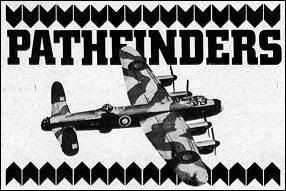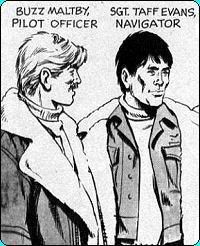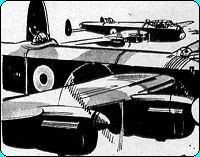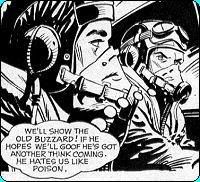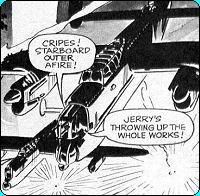 |
||||||
      |
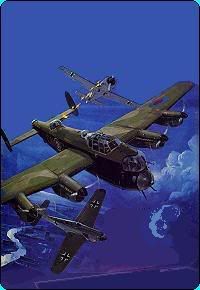 |
|
      |
|||
|
|
||||||
|
|
(Article by Shaqui Le Vesconte) 'Pathfinders' is an oddity of the early action strips in 'Look-In', based not on a primarily children's show but the first to be tied-in to a primetime drama. The 13-part film series aired in the London region (and a few others: Southern, HTV and Border) from late September 1972, concerned 697 Squadron whose job was to fly ahead of RAF bombing missions over wartime Germany, dropping flares to pinpoint targets. A feature appeared in issue 46, dated 11 November, with beautiful cover art by the late Angus McBride - an atmospheric painting (the original of which still exists) showing a Lancaster bomber fending off two German Messerschmitt fighters. The series, according to the 'Look-In' feature, 'represents the fulfilment of a dream' for creator/producer Gerry Brown, whose father had served in the RAF. Inspired by childhood memories of watching Lancasters taking off, Brown had worked on the famous 'Dam Busters' film in 1955 and, after years of research and planning, came to make 'Pathfinders'. The main selling point of the series was its authenticity, what might be called a 'docudrama', and viewed now this may be its failing, as compared to slicker ITC film series like 'UFO', 'The Persuaders' and 'The Protectors' some episodes come over as slightly dull. The bold, but possibly more realistic, move to only have two regulars in Wing Commander Angus MacPherson (Robert Urquhart) and Doctor Bruce Saxon (Jack Watling), leaves viewers only the length of a single episode to get to know each crew, as they changed from week to week. Having said that, this can make other episodes notably dramatic as - like the reality of war itself - you never know who is going to live or not. The series does feature a lot of young names who would go onto greater things: Dennis ('Minder') Waterman and Mark ('Taggart') McManus to name but two, among the more established names like Ray Brooks and Geoffrey Bayldon, fresh from his stint on 'Catweazle'. Anthony Valentine carries most of the episode 'One Man's Bomber', playing a pilot forced to fly a Lancaster solo when a short-lived fire makes him order his crew to bail out. 'Fly There, Walk Back' has notably violent scenes, as a crew stranded in Germany struggle against odds to make it to neutral Switzerland and safety. One episode, 'Jonah Man', where a navigator is deemed bad luck, seems to inspire the 'Pathfinders' strip in the 1973 annual, where a plane dubbed 'H-Hoodoo' seems similarly fated. With 'Countdown' having snapped up the ITC series for strips, it may have been the lack of other filmed drama available at the time that contributed to 'Pathfinders' being chosen by 'Look-In'. Its attempt at almost educational realism may also have been a factor, a similar line of thought perhaps behind the 'World At War' tie-in feature and strip the following year.
The 'Pathfinders' strip replaced
'Catweazle' inheriting, for the first part only, its artist Alan Parry
before he was moved on to do 'The Adventures of David Cassidy'. Parry's
unsigned and differently styled artwork has thrown comic experts for years
but he confirmed doing these in a recent interview (coming exclusively to
'Look-Out' soon!). Parry's successor was a foreign, possibly Spanish,
artist signing himself 'Asian' who sometimes worked with Vicente Alcazar,
associate of another 'Look-In' artist Carlos ('Freewheelers') Pino. The
later strips, including the one in the 1973 annual, were by veteran
illustrator F.A. (Frederick Alan) Philpott.
|
|||||
| Chronology | Strips | Home | ||||
|
6.0 |
||||||
 |
||||||
